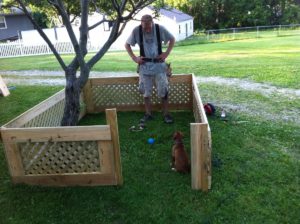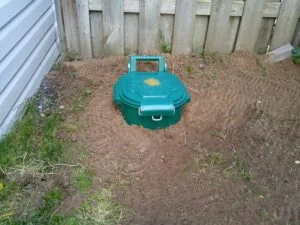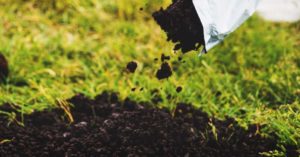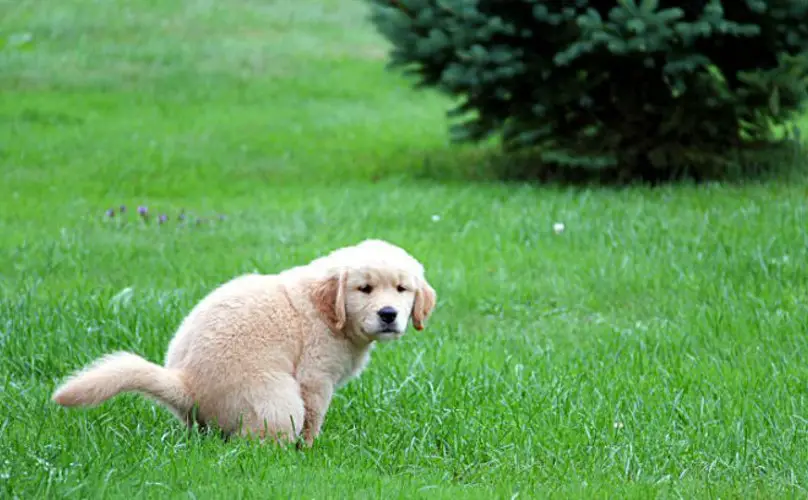You may be wondering what to do with your backyard dog poops, whether to get rid of them or convert them to a useful purpose. But before you consider discarding your dog poop, read this article to the end to see what you might do with your dog poop.
It has been confirmed that dog poop contains a lot of protein because of its high protein-based diet, like beef, lamb, poultry, pork, fish, rabbit etc.
Dog poops are more acidic because of a high level of nitrogen elements found in them than cow or horse poops which are low in nitrogen but serve more as a great all-purpose fertilizer.
Because of the high level of nitrogen in dog poops, using it in your backyard garden as manure without decomposition may result in soil acidity.
Acidic soils (pH 4.0-5.0) can have high concentrations of soluble aluminium, iron, and manganese, which may be toxic to the growth of some plants.
However, dog poop can be a poison that inhibits the growth of grass in your lawn; they are also the most common carriers of diseases and pathogens such as hookworms, roundworms, parvovirus, whipworm, threadworms, Salmonellosis, Cryptosporidiosis, Campylobacteriosis, Parvo, Corona, Giardiasis, and they contain up to 23 million coliforms bacterial per gram of poop.
Dog poops aren’t just an eyesore. It can also be harmful to humans when it contaminates our fruits, vegetables and water when not properly disposed of.
Some micro-organisms found in dog poop like bacteria can cause intestinal illness, rashes, diarrhoea, cramps, ear infections, flu-like symptoms, vomiting, vision loss, and severe kidney disorders to human health. It is as high as third on the list of contributors to contaminated water.
What To Do with Backyard Dog Poop

When we talk about what to do with backyard dog poop, we’re talking about converting it to a useful purpose, and we can only put it to good when we decompose to be used as manure.
Usually, dog poop can take a year to decompose fully. That’s why, when applied to your lawn without being decomposed will make your lawn brown and patchy.
However, there are easier ways to decompose your backyard dog poop. But before then, it is important to let you know if your backyard dog poop can be used as a fertilizer. If you compost the dog poop correctly, you can destroy the harmful pathogens found in dog waste.
Composting lessens the chances that dog poop will pollute groundwater and streams. This compost can be used as straw material and can be a good source of plant nutrients for your potted plants and garden.
Can Backyard Dog Poop Be Used as Fertilizer?
Dog poop is usually not good to use in gardening for some reason, although it’s possible to benefit from it. On the other hand, manure from cows, horses, or sheep is a mostly undigested plant fiber, making it relatively inoffensive to humans because it doesn’t smell as bad. After a few days breaking down, it’s no longer recognizable as poop, so we don’t get the same disgust reaction to it.
But dog poop contains a lot more protein and very little fibre, and that means it has a powerful smell and looks a lot like human poop, which we have a natural aversion to because human poop smells and spreads human diseases.
Dog poop is also less safe to handle since dogs can share intestinal infections with humans, and in fact, dogs often have human infections because of how closely they live with us.
Also, the nutrient profile in dog manure is very different from that of herbivores. Plants can grow directly in or through cow, sheep or horse manure because it is primarily made of plants the cow, sheep, or horse ate and has an ideal balance of nutrients for plants.
Since dogs are carnivores, dog poop is extremely high in protein and nitrogen, so much that it would burn a plant’s roots, so it must be diluted by mixing it with a large quantity of soil.
At the same time, dog manure is lower in potassium which is needed in the soil to encourage leafy herbaceous growth rather than flowers and fruits.
So, using dog poop on your garden would require a few more steps that you wouldn’t have to go through than buying cow, sheep or horse manure. Rather than becoming a pollutant, dog poop can become a nutrient for your garden after going through decomposition.
If you have a garden, you can make your compost bin by adding dog poop to grass clippings, plant or other organic waste, and even sawdust as a source of food for the microbes.
Benefits of Decomposing Your Backyard Dog Poop
- Composting removes raw dog waste from the environment, where it can pollute groundwater and streams.
- Good composting destroys pathogens and produces a safe soil amendment.
- Good on-site composting eliminates transporting dog waste to a disposal facility. This saves time, money, energy, and landfill space.
- Good composting produces a quality soil additive that improves the soil’s physical condition and fertility.
How To Decompose Your Backyard Dog Poop

There are several ways to decompose your backyard dog poop properly without causing harm to either you or other people around you. For instance, you pick up your dog poop using non-biodegradable bags, your only real option for disposal is to toss the poop in the garbage, preferably the one outside.
But that can cause quite a stink as the poop festers and sprouts big globules of maggots between trash pickups. The best way to dispose your dog poop is to avoid it from getting fester, grow maggots, and stink up the place or sending it to the landfill in a plastic grocery bag. But if you follow the steps below, you will be able to decompose your backyard dog poop in more exciting and beneficial ways.
- Ture Fallen Leaves into Compost Too
In autumn, you can use fallen leaves as a good source of compost. It’s OK to add these to your compost bin, but you might prefer to place them in a large biodegradable leaf bag if you have large amounts of leaves.
Once you’ve gathered up your fallen leaves, they can be left to turn into a brilliant source of moisture-rich soil improver that’s great to use for potting mixes as an alternative to peat.
The leaves will be kept neatly in one place, and the sack will biodegrade, leaving you with a rich pile of wonderful compost.
- Add Kitchen and Yard Waste as They Accumulate
Collect your kitchen compostable in a container in your kitchen. Find a handy place to store this container, preferably under the sink or in the freezer. When it is full, empty its contents into the compost bin. Whenever you add food scraps or yard waste, be sure to top it with a layer of browns.
If you do not add browns, your compost will be wet and break down more slowly. Depending on the type of compost bin or pile you have chosen, they may be specific ways of adding and maintaining compost. Most of the composters you purchase come with instructions; follow these instructions for best results.
- Using Puppy Pen (Wire Bin)
Puppy pens are a perfect choice for composters with only a few dogs with plans to add many leaves and grass clippings to their compost. You can find commercial versions of these wire bins, making them convenient for those who don’t want to build their own.
Be aware that wire bins with large openings may have trouble containing compost. But like other wire bins, this design provides moist air to the compost material, producing hot, fast compost.
Wire bins do not retain heat as well as plastic or wood bins. They are probably not a good choice for cool, wet climates or areas with a frost-free season of two months or less.
- Flushing
The Environmental Protection Agency suggests that the most environmentally friendly way of disposing dog poop is to flush it. “The water in your toilet goes to a sewage treatment plant that removes most pollutants before the water reaches a river or stream,” according to a pamphlet on pet waste and water quality.
Scooping it up from the yard and dumping it straight in the toilet is the safest and most eco-friendly way to do this, but there are also water-soluble bags made of polyvinyl alcohol film and designed to be flushed. The film dissolves in water, and the rest of the bag and its contents should dissolve in about 30 days.
These aren’t entirely reliable if you have dubious plumbing. You should check with your water and sewage treatment center to ensure it can handle the pathogens in pet waste before trying this method. It isn’t advised for septic systems because the hair and ash found in pet waste can overwhelm them.
- Using Tumbler Bins
Tumbler-type compost bins tend to be more expensive to build or purchase. Some incorporate a pipe for passive aeration, but all are intended to be rotated to stir the compost. For many tumbler models, rotating the bin is more complicated than it looks. Physics is on your side, but you are still moving the entire contents of the bin at one time.
Some bins have the annoying habit of losing the lid and dumping the contents on your feet. If possible, try using the tumbler before you purchase it. However, Tumbler bins should not be filled more than about one-half full to leave room for mixing. Tumblers allow less air to reach the compost material than many other systems and may not reach the high temperatures you can expect with wire bins.
- Worm Farming
Worm farming may be the most natural, practical and green way to get rid of dog poop, and you can even do it without a yard. It also can be a way to dispose of your organic kitchen waste, such as potato peels and apple cores. Worms eat the waste, digest it, and eliminate the odor.
The worm poop can be used as a soil conditioner, and the liquid that drains from the worm farm can be used for fertilizer in your yard or garden, but not where you grow food. However, an Australian company recommends the Worm Swag because it’s so compact and easy to use, especially for novices.
If you feed the worms both pet waste and veggie waste, you should also provide a high carbon source such as newspaper or leaves. Thus, disposing of dog waste with a worm farm also helps you go green with other types of waste, naturally.
- Using Pallets Bin
Wooden bins that are made from pallets or slab wood are cheap and effective. You can build a bin with four pallets and a few feet of twine in less than an hour in your backyard. Pallet bins are not very flexible in terms of size, are very heavy and can make turning the compost difficult.
Wood tends to decompose over time, and bins will have to be replaced after a few years, particularly in wet climates. Pallet bins are an excellent choice for storing carbon materials and finished compost.
Pallet bins allow the compost material to receive plenty of air, but they are not a great choice if rodents or other pests are a problem. Lining a pallet bin with hardware cloth is an option if pests are a problem.
How to Use Your Backyard Dog Poop After Being Compost

Suppose you have maintained a proper composting system. In that case, your dog waste compost, humanure compost, chicken manure compost, or even fresh dirt will have no pathogens, and I recommend it be used on your lawn, on ornamental bushes, and around your trees.
I have about a dozen coconut and many banana trees that are always searching for additional nutrients. If you have fruit trees, a hedge, or a lawn, they will appreciate the compost and pay you back by flourishing.
The compost is ready to be used when it looks like regular soil. I cannot tell you an exact amount of time because it will vary depending on your environmental conditions. Below are how to use your backyard dog poop.
How to Use your Backyard Dog Poop
- Sprinkle your lawn a few times a year.
- Use your compost as a top dressing for flower beds and at the base of trees and shrubs.
- Mix compost in with garden and flower bed soil.
- Use as a soil conditioner when planting or transplanting trees, flowers and shrubs by filling the hole with half compost and half soil.
- Make ‘compost tea.’ Fill cheesecloth or an old pillowcase with 1 liter of compost. Tie the top and ‘steep’ the bag overnight in a garbage can filled with water. This ‘tea’ can be used to water plants and gardens.
CHECK OUT THIS:
- What Do Backyard Bunnies Eat?
- Do Backyard Ponds Attract Mosquitoes
- Do Backyard Chickens Attract Flies
- Is Backyard Farming Profitable? – Top 10 Profitable Backyard Farming in The U.S

